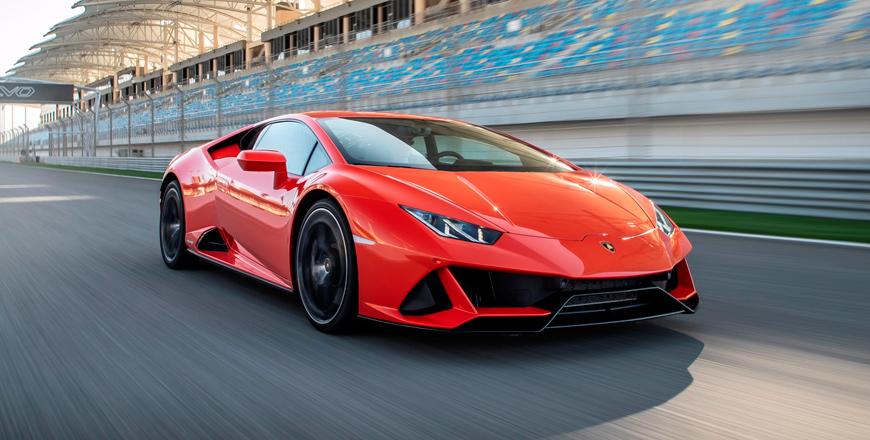You are here
Lamborghini Huracan Evo: Evolution of an alpha predator
By Ghaith Madadha - Dec 14,2020 - Last updated at Dec 14,2020

Winner of the 2020 Middle East Car of the Year’s Best Performance Coupe prize and runner up for the top award, the Lamborghini Huracan Evo first arrived in 2019 as a mid-life refresh for the junior model of the Italian car maker’s two supercars. Adopting the “Evo” moniker to indicate revisions are beyond just skin deep, the new Huracan gains much from the pre-facelift model’s sophisticated high performance Huracan Performante edition. The Evo also most importantly adds four-wheel-steering, revised electronic driving dynamic integration and a more user-friendly infotainment system.
Dramatic down-force
As jutting, low, visceral and sharp as ever with its athletically predatory posture and palpable sense for the dramatic, the subtly restyled Huracan Evo features new triangular front cooling ducts and more horizontally-oriented bumper designs, front and rear. It also includes redesigned sill-mounted side air intakes located at the pinched-in section just behind the cabin and ahead of its muscular rear wheel-arches. Restyled primarily for improved aerodynamics, the Huracan Evo benefits from lessons learned from the Performante, but without its complex active air flow management set-up and wild rear wing.
Instead, the Evo achieves significantly improved down-force and about five times better aerodynamic efficiency than the original Huracan — circa 2014 — through fixed underbody airflow management and a slotted integrated and now raise rear deck spoiler. Built using stiff and lightweight aluminium and carbon-fibre construction, the Huracan also gains an improved next generation central processing vehicle dynamic system that not just reacts to, but predicts dynamic attitudes. Monitoring various inputs, this optimally adjusts adaptive dampers, four-wheel-drive, torque vectoring and traction control settings and can even direct traction to one wheel if necessary.
Seamless and searing
Powered by the same version of Lamborghini’s scintillating mid-mounted, dry sump, naturally-aspirated 5.2-litre V10 engine as the outgoing Performante, the Evo returns almost identical performance figures that make significant gains over it direct standard specification Huracan predecessor. Developing 30BHP and 29lb/ft over the previous Huracan, the new Evo produces a mighty 631BHP at 8,000rpm and 442lb/ft torque at 6,500rpm. Combined with a relatively low 1,422kg weight, tenacious four-wheel-drive off the line traction and swift bolt-action like gear changes, this translates into exhilarating 2.9-second 0-100km/h and 9-second 0-200km/h acceleration and a 325km/h maximum.
Responsive from idling and pulling viciously through to a high-strung rev limit, the Evo develops power and torque in a seamlessly swift and searing sweep, with unbridled urgency and surprising versatility that includes an estimated 70 per cent of torque being available from just 1,000rpm. Razor-sharp in its reflexes, the Evo’s engine allows one to unleash precise increments of power and dial back revs with near immediacy, while braking distance is just 31.9-metres from 100km/h. An acoustic treat, the Evo’s soundtrack coalesces from mechanical staccato to resonant metallic snarl, before hardening to wailing howl.
Sure-footed yet nimble
Decisively swift yet slick through cogs with its 7-speed dual-clutch gearbox, one can shift through fixed column-mounted manual mode paddle-shifters or auto mode in different, escalating response levels. Driving all wheels with a rear bias, the Huracan Evo can however alter power distribution from rear to front and side to side along the rear axle through a limited slip differential for maximum stability, agility and road-holding. Sure-footed yet nimble, the Evo also benefits from brake-base torque vectoring for added turn-in agility, while ventilated, perforated carbon ceramic disc brakes are tirelessly effective.
An exhilarating drive with its scalpel-like reflexes and immersing, connected driver-involvement, the Evo’s responses and levels of driver involvement are almost telepathic. Reacting with precision to the smallest or biggest inputs, one feels always in control and at the centre of the action, with the Evo’s biggest improvement over its predecessor being its four-wheel-steering. With rear wheels turning in the same direction to effectively shorten its wheelbase and enhance agility at low speed, the Evo’s rear wheels meanwhile turn in the same direction for added lane change stability at higher speeds.
Agile and accessible
Driving with the agility and maneuverability of a smaller even more nimble sports car thanks to four-wheel-steering, the Evo turns crisp and tidy into corners, changing direction on a whim and with a flick of the wrist. Balanced throughout a corner owing to slightly rear-biased within-wheelbase weighting, the Evo meanwhile remains flat, with excellent body control from its adaptive dampers. Digging its huge 305/30R20 rear tires into tarmac, the Evo meanwhile exits with committed grip, but is nevertheless is willing and adjustable when tightening a cornering line.
Stable at speed and settled in vertical movement, the Evo is meanwhile a smooth and comfortable daily supercar in its most forgiving suspension setting, with a reversing camera and four-wheel-steering to make parking less daunting despite limited rear visibility. Easily accessed through up-swinging doors, the Evo features snugly supportive sports seats and good front views. Space is decent even for taller drivers and long journeys, but slightly more headroom wouldn’t go amiss. Driver-focused in layout and awash with luxuriously sporty Alacantara inside, the Evo’s new 8.4-inch vertical touchscreen infotainment system features improved connectivity and voice activation.
TECHNICAL SPECIFICATIONS
Engine: 5.2-litre, mid-mounted, dry sump, V10-cylinders
Bore x stroke: 84.5 x 92.8mm
Compression ratio: 12.7:1
Valve-train: 40-valve, DOHC, direct injection
Gearbox: 7-speed automated dual clutch
Driveline: Four-wheel-drive, double-plate clutch, mechanical self-locking rear differential
Power, BHP (PS) [kW]: 631 (640) [470] @8,000rpm
Specific power: 121.3BHP/litre
Power-to-weight: 443.7BHP/tonne
Torque, lb/ft (Nm): 442 (600) @6,500rpm
Specific torque: 115.3Nm/litre
Torque-to-weight: 422Nm/tonne
0-100km/h: 2.9-seconds
0-200km/h: 9-seconds
Top speed: 325km/h
Fuel consumption, combined: 13.7-litres/100km
CO2 emissions, combined: 332g/km
Fuel capacity: 83-litres
Length: 4,520mm
Width: 1,933mm
Height: 1,165mm
Wheelbase: 2,620mm
Track, F/R: 1,668 / 1,620mm
Dry weight: 1,422kg
Weight distribution, F/R: 43 per cent / 57 per cent
Luggage volume: 100-litres
Chassis: Aluminium and carbon-fibre
Steering: Electric-assisted rack & pinion, all-wheel steering
Turning circle: 10.9-metres
Suspension: Double wishbones, optional adaptive magnetic dampers
Brakes, F/R: Ventilated, perforated carbon-ceramic discs 380 x 38mm / 356 x 32mm
Brake calipers, F/R: 6-/4-piston calipers
Braking distance, 100-0km/h: 31.9-meters
Tyres, F/R: 245/30R20 / 305/30R20
Related Articles
Historically playing second fiddle to Lamborghini’s glamorous V12 supercars, the Italian carmaker’s 1972-88 Urraco, Silhouette and Jal
The refreshed ragtop version of the iconic Italian automaker’s “junior” supercar line, the Lamborghini Huracan Evo Spyder’s revisions go bey
With no shortage of desirable, fast and viscerally styled cars to its name since it was founded in 1963, the recently launched Lamborghini H


















